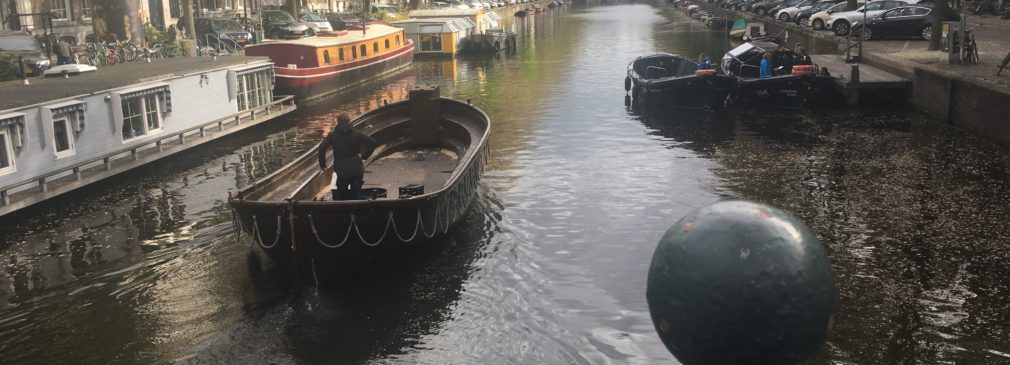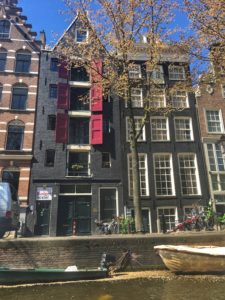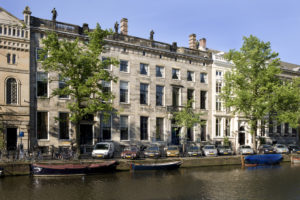
Share
Keizersgracht Canal image courtesy Jennifer Simonson
Nicknamed “Venice of the North,” the history of Amsterdam is intimately connected to its 60 miles of canals flowing through the city. The Dutch first dug canals in the Middle Ages as a defense system, but as the city expanded the defense moats ended up inside the city’s walls. Merchants began using them to transport goods from the canal-lined warehouses to the rest of Europe. Trade exploded during Amsterdam’s Golden Age in the 17th century prompting officials to build three main canals through the heart of the city. Those canals, The Herengracht, The Prinsengracht and The Keizersgracht, are now a UNESCO world heritage site. Like identical triplets, each canal looks the same to the outside eye, but each offers its visitors something unique.
The Herengracht, or the Gentleman’s Canal, is the most prestigious of the three canals. It is where the richest merchants and the most influential politicians lived and an address along this canal still holds the most esteem. The Prinsengracht, or Prince’s Canal, is the longest of the three canals and provides an address for some city’s most recognizable sites like the Anne Frank House. And the Keizersgracht, or Emperor’s Canal (it was named after Emperor Maximilian of Austria), is the widest and offers visitors several opportunities to experience for themselves the history behind each charming canal house door.

The red shuttered warehouses-turned-luxury-apartments at Keizersgracht 44 once stored whale blubber. The three houses built in 1620 on behalf of the Greenland Walvisch Company preserved tens of thousands of liters of whale oil used at the time to make soap, lamp oil and paint.
The historic iron gate guarding The Dylan Hotel at Keizersgracht 384 is all that remains of The Duytsche Academie, Amsterdam’s first actor’s theater. Opening in 1613, the theater produced hundreds of performances that entertained the era’s well-known guests such as the King of Poland, the Russian Tsar and the Elector of Brandenburg. Antonio Vivaldi conducted the theater’s orchestra on its 100th anniversary and the theatre produced the country’s first female performance. Tragically, on Monday May 11, 1772 a fire broke out during a performance burning down the wooden theater and killing 11 people.
In 1773 the Roman Catholic Church bought the property to bake bread for the city’s old and poor residences. Today, those same bread baking ovens adorn the Dylan Hotel’s Vinkeles restaurant, a seven-table Michelin star contemporary French restaurant. Now the Dylan, a 40-room boutique hotel, has the feel of old world luxury with marble floors, wood-paneled walls, dark leather upholstery and continuously burning fireplace.

At Keizersgracht 672, the Museum van Loon was once the home of the esteemed van Loon family. The museum preserves that 17th century life with lush, manicured garden, luxurious, classic furniture, and exquisite decor. The coach house still smells like horses, giving visitors a whiff of what life was like during Amsterdam’s golden era.
The House Marseille at Keizersgracht 401 is Amsterdam’s first photography museum. Situated in wealthy French merchant Isaac Focquier’s 1655 canal house, visitors can walk through the 14 exhibition spaces and know they are walking through the original 17th century lay-out with much of the original style and decorations retained throughout the building.
The hub of culture, science, and the arts sits at Keizersgracht 324. Felix Meritis, meaning happiness through merit, was a society established in 1777 to promote of arts and sciences. The impressive building built in 1787 housed five ‘branches’ of the society: music, drawing, literature, economics and physics. It acted as a performance hall for musicians like Mozart, Schumann and Brahms. Today it houses a European center for arts, culture and science and hosts , a large variety of cultural meetings and performances.














